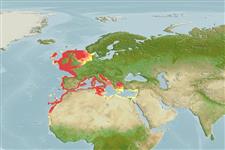Actinopterygii (ray-finned fishes) >
Pleuronectiformes (Flatfishes) >
Soleidae (Soles)
Etymology: Microchirus: Greek, mikros = small + Greek, cheir = hand (Ref. 45335).
Environment / Climate / Range
Ecology
Marine; demersal; depth range 20 - 400 m (Ref. 35388). Subtropical, preferred 21°C (Ref. 107945); 60°N - 15°N, 18°W - 36°E
Northeast Atlantic: British Isles south to Senegal (baie du Lévrier) and the Mediterranean.
Length at first maturity / Size / Weight / Age
Maturity: Lm ?, range 14 - ? cm
Max length : 35.0 cm SL male/unsexed; (Ref. 35388); common length : 14.0 cm TL male/unsexed; (Ref. 3397); max. reported age: 14 years (Ref. 32766)
Dorsal
spines
(total): 0;
Dorsal
soft rays
(total): 0. Upper eye less than its own diameter from dorsal profile of head. Anterior nostril on blind side not enlarged, its distance from front margin of head about twice in its distance from cleft of mouth. Anterior nostril on eyed side with backward-pointing tube reaching to front border of lower eye. Pectoral fin on eyed-side small, on blind side reduced.
Inhabits mud or sand bottoms. Feeds on a wide range of small bottom-living organisms, mainly crustaceans (amphipods, shrimps), also polychaete worms and bivalve mollusks (Ref. 4710). Utilized as a food fish.
Robins, C.R., R.M. Bailey, C.E. Bond, J.R. Brooker, E.A. Lachner, R.N. Lea and W.B. Scott, 1991. World fishes important to North Americans. Exclusive of species from the continental waters of the United States and Canada. Am. Fish. Soc. Spec. Publ. (21):243 p. (Ref. 4537)
IUCN Red List Status (Ref. 115185)
CITES (Ref. 94142)
Not Evaluated
Threat to humans
Harmless
Human uses
Fisheries: commercial
More information
ReferencesAquacultureAquaculture profileStrainsGeneticsAllele frequenciesHeritabilityDiseasesProcessingMass conversion
Tools
Special reports
Download XML
Internet sources
